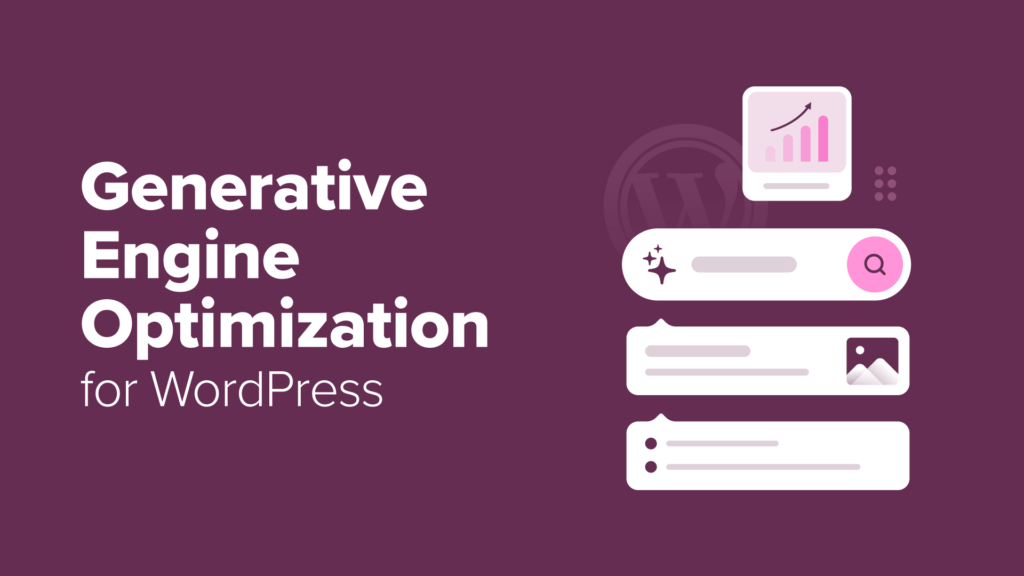I still remember the first time one of my articles appeared in the top 3 search results, but Google’s AI Overview credited someone else.
The frustrating part? The information came directly from my post. 😒
That moment really opened my eyes. That’s why I’ve spent the last several months studying how AI search tools like Google’s AI Overview, ChatGPT, Gemini, and Claude pull information.
I’ve tested different formats, structured data settings, and optimization strategies across multiple WordPress sites.
In this guide, I’ll break down what Generative Engine Optimization (GEO) means for WordPress users. You’ll learn how it works, how it compares to traditional SEO, and what specific steps you can take to help your content show up in AI answers — even if you’re not a tech expert.
If you’ve been worried about losing traffic or falling behind, you’re not alone. I’ve been through the same frustration. That’s why I created this guide: to help you adapt more quickly and with less stress.
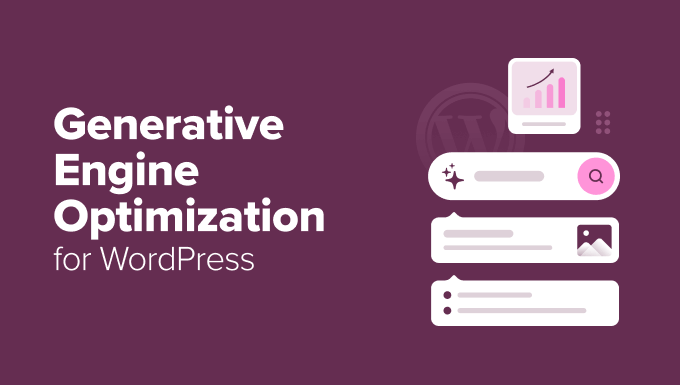
Here is a quick overview of the topics I’ll cover in this guide:
What Is Generative Engine Optimization? (And Why It Matters for WordPress)
Generative Engine Optimization (GEO) means structuring your content so that AI tools like ChatGPT, Google’s AI Overview, Claude, and Gemini can easily understand, summarize, and include it in their answers.
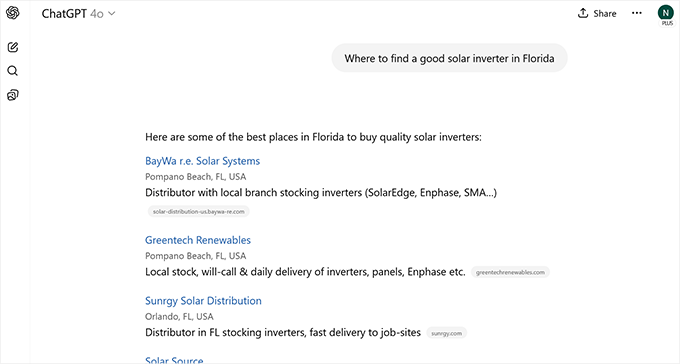

These AI tools aren’t just scraping the web. Instead, they’re scanning for structure, clarity, and relevance. If your content is well-formatted, direct, and easy for language models to process, it has a better chance of being included in AI-generated answers.
Think of it like SEO, but instead of optimizing for search engine bots, you’re optimizing for AI models trained on massive amounts of text.
GEO doesn’t replace traditional SEO. It builds on it by focusing on how modern AI tools interpret and reuse information.
AI Search Is Already Here (And It’s Eating Your Traffic)
When Google first rolled out AI results, I figured they wouldn’t affect much. But I was wrong. In some cases, the summary used my content, but no one clicked through to my site.
And I’m not the only one who’s noticed this.
A recent study by Ahrefs analyzed 300,000 keywords and found that when Google showed an AI Overview, the top-ranking page saw a 34.5% drop in average clickthrough rate compared to similar results without AI.
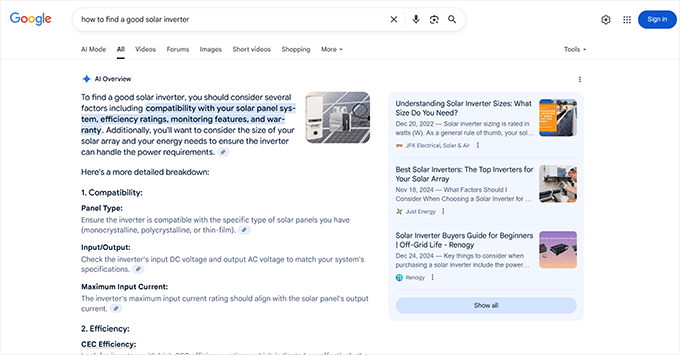

AI tools are changing how people get answers. They often pull responses directly from existing content, and many users do not need to click past the summary.
In a recent interview, Cloudflare CEO Matthew Prince shared: “Today, 75 percent of queries get answered without you leaving Google.”
If your site is not included in that AI-generated answer, you are missing out on visibility and potential traffic, even if you are still ranking high in traditional search results.
The good news is that WordPress gives you the tools to adapt. With WordPress SEO plugins like All in One SEO, clear formatting, and structured content, you can prepare your site for both traditional rankings and AI search results.
That’s what helped me get my posts noticed again, and it can help you, too.
GEO vs SEO: What’s Different, What’s the Same?
SEO and GEO often overlap, but they have different goals. Traditional SEO helps your site rank in search results, while GEO helps your content get included in AI-generated answers.
With SEO, you’re optimizing for search engine bots that index and rank pages. With GEO, you’re optimizing for AI tools that summarize and generate answers. Both are important, but they reward different strategies.
Here’s a quick comparison of how SEO and GEO compare:
In simple terms, SEO helps people find you. GEO helps machines understand and use your content when answering someone’s question. If you want to stay visible, you’ll want to do both.
How AI Search Works Behind the Scenes
To optimize for AI search, it helps to understand how these tools work behind the scenes.
While each platform is different, they tend to follow similar patterns when deciding what content to summarize, cite, or ignore.
How Google AI Overviews Choose What to Display
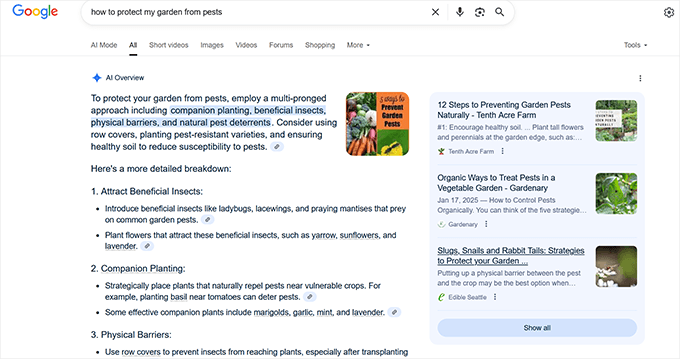

Google isn’t guessing when it builds an AI Overview. It looks for content that’s clear, well-structured, and trustworthy.
From what I’ve observed, the following factors can increase your chances of being included:
Pages that already rank well organically, but not always
Content with short, direct definitions or summaries near the top
Posts with step-by-step formatting, like numbered lists or how-to blocks
Pages using schema markup for FAQs, HowTo, and definitions
Sites that show author names, publish dates, and E-E-A-T signals
Even if your content isn’t ranking in the #1 spot, it can still appear in the AI Overview, as long as it’s structured clearly. I’ve seen this happen on some of my own articles after I added schema and rewrote the introduction.
How ChatGPT, Claude, and Gemini Pull Info From Your Site
AI tools like ChatGPT, Claude, and Gemini don’t index pages the same way Google does. Instead, they use web crawlers or partner APIs to collect and learn from your content.
It’s helpful to know that some AI answers come from the model’s “memory” (its training data, which can be months old), while newer AI tools can browse the live web for up-to-date information.
If your site is public and crawlable, it may be part of the training or retrieval process, especially for tools like ChatGPT that include browsing or plugin features.
Even if they’re not pulling content in real time, AI models trained on older data can still paraphrase your writing.
That’s why formatting, clarity, and author signals are so important — they help models understand who said what, and how to attribute it.
What Makes Content “AI-Ready” (According to LLM Behavior)


I’ve tested dozens of prompts using content I’ve written, and the same pattern keeps showing up. AI tools prefer content that is structured, concise, and easy to break into smaller pieces.
Think of your blog post like a Lego set.
If it’s well-organized with labeled parts like subheadings, summaries, and schema, AI tools can easily pick out the pieces they need. If it’s just a wall of text, they are more likely to skip over it.
How to Optimize WordPress Content for Generative Engines (GEO Steps)
Now that we understand how AI search can be used to bring traffic to your website and improve its visibility, let’s look at some practical steps that you can apply right now.
Step 1. Choose the Right SEO Tool for the Job
If you’re using WordPress, the easiest way to optimize for AI search is by using the All in One SEO plugin. It’s already the best SEO plugin for WordPress — and in my experience, it’s also the most powerful tool for Generative Engine Optimization.
We use AIOSEO on WPBeginner and all our partner sites, and we’ve seen a noticeable improvement in AI Overview visibility since making a few small changes with its tools. See our full All in One SEO for WordPress review for more details.
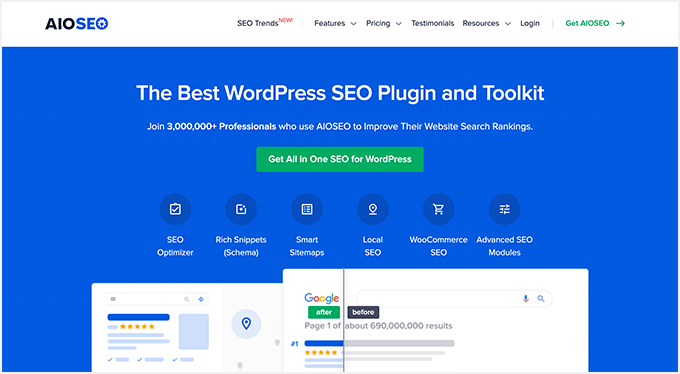

It gives you full control over how your content appears in both search results and AI-generated answers.
Here are some of the key AIOSEO features I rely on for AI search optimization:
Schema Markup: Easily add HowTo, FAQ, Article, and custom schema to any page.
TruSEO Analysis: Get real-time suggestions to improve structure, readability, and clarity.
FAQ Blocks: Add machine-readable FAQs that help trigger AI citations.
Author + Publisher Info: Add structured author bios and business details to boost E-E-A-T signals.
In the steps below, I’ll show you how to apply these tools and strategies to your own content. If you already use AIOSEO, you’ll be able to follow along easily.
If not, then install and activate the All in One SEO for WordPress plugin. Here is our complete guide on how to set up All in One SEO for WordPress.
Note: A free version of All in One SEO is also available. You can give it a try, but I recommend upgrading to the paid version to unlock its full potential.
Step 2. Use Clear and Concise Language That AI Can Interpret
One of the biggest things I’ve learned is that AI tools don’t read like humans. Instead, they break content into small parts to understand what it means.
If your content uses complex language or too much jargon, then it becomes harder for AI tools to understand and quote it correctly.
When I rewrote some of my posts using shorter sentences and simpler words, I started seeing more of them appear in ChatGPT and Gemini responses. Clear content isn’t just better for people. It’s better for machines, too.
Here’s what I try to follow when writing for both readers and AI:
Keep sentences under 20 words whenever possible.
Use simple vocabulary unless a technical term is absolutely necessary.
Break long paragraphs into smaller ones, with one idea per paragraph.
Avoid run-on sentences, complex punctuation, and clever phrasing that might confuse AI tools.
Put the key point at the beginning of the sentence, then explain or expand after.
AIOSEO’s TruSEO score often flags issues like sentence length and clarity.


It analyzes your content for ideal paragraph and sentence length, active voice, transition words, consecutive sentence patterns, subheading usage, and Flesch readability score.
I use those suggestions as a quick check to make sure my posts are easy to scan, not just for readers, but for AI tools too.
You can see our guide on how to add and improve readability score in WordPress for more details.
Step 3. Include Direct Answers to Common Questions (Prompt Framing)
AI tools like ChatGPT and Gemini are designed to answer questions quickly. So if your content sounds like a clear answer to a common question, there’s a much better chance it’ll get used in AI responses. This approach is called prompt framing.
When I started rewriting my content to lead with short, direct answers, I noticed it getting picked up more often by AI tools. Instead of burying the answer in a long paragraph, I give it upfront, then explain the details below.
Here are a few real-world examples:
Original (food blog): Making banana bread is a simple process that involves mixing ripe bananas with other basic ingredients and baking until done.
GEO-Optimized: To make banana bread, mash ripe bananas and mix them with flour, sugar, eggs, and baking soda. Then bake at 350°F for about 50 minutes.
Original (travel site): Many travelers enjoy visiting Italy because of its food, history, and scenic views.
GEO-Optimized: The best time to visit Italy is in spring (April to June) or fall (September to October) when the weather is mild and crowds are smaller.
Original (personal finance blog): Having an emergency fund can reduce financial stress and help you manage unexpected expenses.
GEO-Optimized: An emergency fund is a savings account you use only for unexpected expenses like medical bills, car repairs, or job loss.
These direct answers match how people ask questions in AI tools. When your content mirrors those prompts, it’s more likely to be selected and cited.
And if you’re using AI to help write your content, this is even easier.
Just tweak your prompt to ask for a short, direct answer first, followed by a more detailed explanation. This structure makes your content much more likely to be quoted by AI tools.
Here’s a simple prompt to show how you can apply it to your AI workflow:
This small change can make your AI-generated content easier for other tools to summarize, cite, and include in search results.
Bonus Tip🎁: Need prompt examples for your blog posts? See our list of well-crafted AI prompts for bloggers and marketers.
Step 4. Add Schema Markup for Better Context
Schema markup is extra code that tells AI tools exactly which type of content you’re publishing, like a tutorial, FAQ, article, or product review.
It helps machines understand the purpose of your page so they can cite it more accurately.
Schema is one of the clearest signals you can add to your website. I’ve seen content picked up more often by Google’s AI Overview and tools like Gemini after adding the right markup, especially for step-by-step guides and FAQs.
Planning your post with schema in mind also makes writing easier.
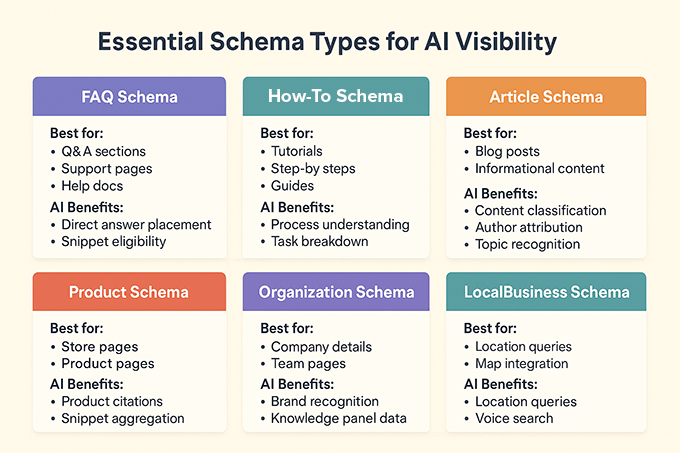

For example, formatting your content as a list of steps, a set of questions and answers, or a recipe with ingredients and instructions gives your content a clear structure that works for both humans and machines.
When I first looked into schema markup, it felt overwhelming. But with All in One SEO, I don’t need to mess with code at all. I just pick the content type from the schema tab and fill in the form to generate schema markup.


Here are some of the schema types I use the most when optimizing for AI search:
FAQ Schema: Helps AI tools pull answers to common questions directly into their responses.
HowTo Schema: Makes it easier for AI to understand step-by-step tutorials or guides.
Article Schema: Adds author info, publish date, and headline context — important for building trust and E-E-A-T signals.
Recipe, Product, or Event Schema: Ideal for food blogs, online stores, or local businesses with structured content.
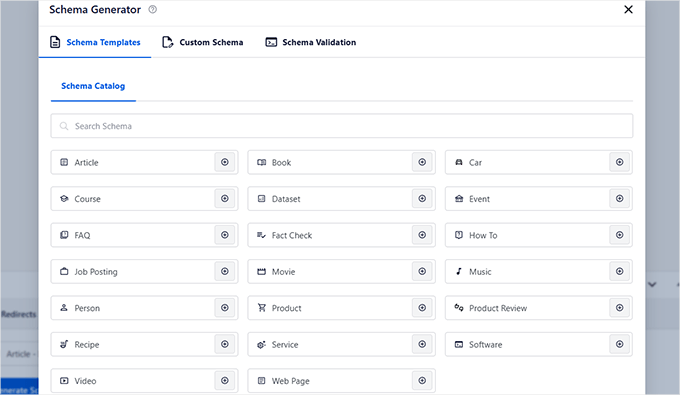

On WPBeginner and our partner sites, we’ve seen strong results in AI visibility after using schema consistently.
Schema is one of the most effective and underused ways to make your content easier to understand and feature.
Step 5. Format Content With Logical Headings and Subheadings
Clear headings and subheadings help AI tools understand how your content is structured.
They show which parts answer specific questions and make it easier for tools like ChatGPT or Gemini to quote the correct section.
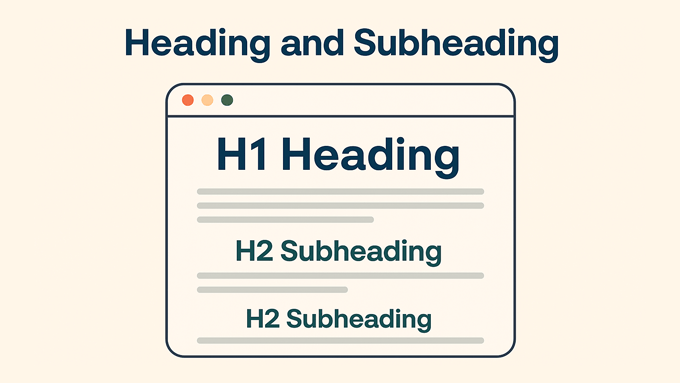

Here’s how I recommend structuring your content:
Use H2 for main topics or major steps in a guide.
Use H3 or H4 for supporting details, examples, or sub-questions.
Write headings that clearly describe the section. Avoid vague titles like “More Info” or “Other Tips.”
Stick to a logical order and don’t skip heading levels (e.g., don’t jump from H2 to H4).
Use question-style headings when possible. This matches how people search and how AI tools interpret prompts.
For more details, see our guide on how to properly use heading tags in WordPress.
Step 6. Include a Short Summary or Definition Near the Top
A short summary or definition at the beginning of your content makes it easier for AI tools to pull quick answers from your page.
This is different from answering multiple questions throughout the post. Think of this as answering the main question right away — like giving someone the TL;DR version before you dive into the details.
Here is an example of how Syed Balkhi used this practice in his article about choosing the best business phone service:
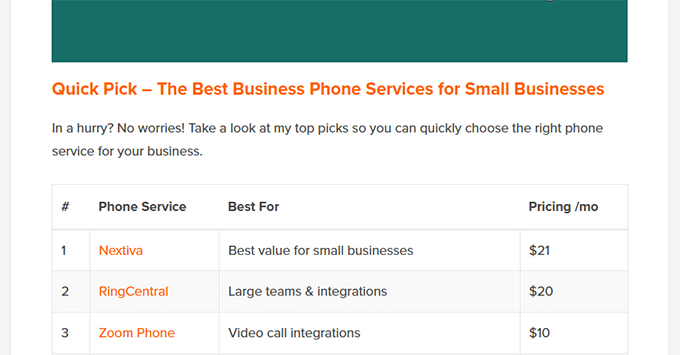

Most AI tools scan the top of your post for a quick explanation. If they find a clear summary in the first few lines, your content is more likely to appear in an AI Overview or chatbot response.
Here’s how I typically structure this:
Write a 1–2 sentence summary or definition right after the heading or intro.
Use simple language — imagine you’re answering a prompt in plain English.
Use bold text or a callout block to help it stand out for both readers and AI tools.
For example, in a post about “what to include in a wedding invitation,” I’d open with:
“A wedding invitation should include the couple’s names, event date, time, venue, and RSVP details. You can also add dress code, gift info, or a personal message.”
This kind of summary helps AI tools provide fast, accurate responses, especially when users are looking for quick answers or definitions. It also improves your chances of showing up in Google’s AI Overviews and featured snippets.
If you’re using AI to help you write content, you can train it to follow this approach. Just start your prompt with:
Step 7. Add FAQ Blocks That Match Common User Prompts
FAQ blocks are not just helpful for readers. AI tools like Google’s Overview and ChatGPT also scan them to find short, clear answers to common questions.
I’ve noticed that when I include FAQs that match what people are actually searching for, those answers are more likely to get picked up by AI. It’s like giving models a ready-made response to show in their results.
For example, let’s say you run a bakery website. You could add FAQ questions like:
How far in advance should I order a birthday cake?A good rule is to place your order at least 3–5 days in advance to guarantee availability.
Do you offer gluten-free cupcakes?Yes, we have gluten-free options available for cupcakes and cakes. Just let us know when ordering.
These types of question-and-answer pairs match how people search in AI tools, which makes them very effective.
I normally add an FAQ section to my article, and then use All in One SEO to add FAQ schema directly in WordPress.
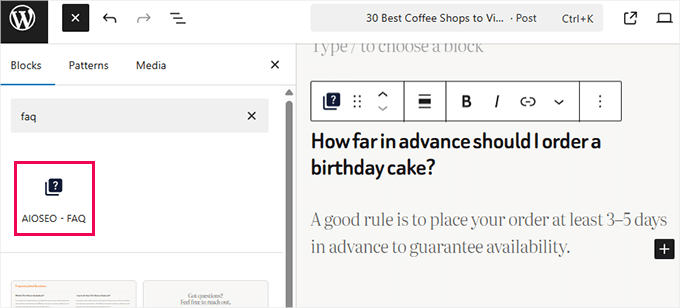

However, AIOSEO also comes with an FAQ block that you can use to easily add an FAQ section and then add the FAQ schema markup.
It’s built right into the block editor, so I can format each Q&A and automatically add the right structured data. That way, both humans and search engines understand what I’m offering.
If you’re using AI to help write your content, try prompting it like this:
Step 8. Use Table of Contents and Jump Links for Structure
When AI tools scan your content, they look for structure. A table of contents (TOC) helps them understand how your post is organized and also makes it easier for readers to navigate.
In longer guides, I include a clickable table of contents near the top. It links to different sections using jump links, which helps both readers and AI tools find what they need.
A table of contents can also help your content appear in rich snippets, which may increase your click-through rate in traditional search results.
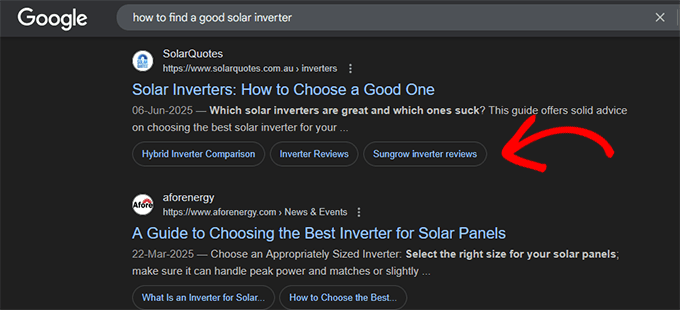

If you’re writing a post like “How to Start a Home Cleaning Business,” your table of contents might look like this:
Choose a business model
Register your business and get licenses
Buy the right cleaning supplies
Set your pricing and offer packages
This type of structure helps readers skim the page and also helps AI tools extract and cite specific answers.
I use the Table of Contents block that comes with All in One SEO because it automatically builds a TOC from my headings. If you aren’t using AIOSEO, then a great alternative is the Table of Contents Plus plugin.
For more options, see our pick of the best table of contents plugins for WordPress.
Step 9. Cite Sources, Use Author Names, and Add Dates for E-E-A-T
Search engines and AI models both want trustworthy answers, and that means looking at more than just your words. They check who wrote the content, when it was published, and whether you’ve backed up your claims with reliable sources.
If you’re serious about showing up in AI results, you need to show you’re a real person with real knowledge. Not just another website blending in.
This is where E-E-A-T comes in. It stands for Experience, Expertise, Authoritativeness, and Trustworthiness.
For example, if you run a travel blog and write about travel insurance, you could cite a source like the U.S. State Department.
Similarly, if you’re giving parenting advice, referencing the American Academy of Pediatrics can help. These aren’t just helpful for readers. They also give AI models more confidence in your content.
Here’s a quick checklist I use to boost trust signals:
✅ Add an author name. Use your real name and include a short author bio with relevant experience.
✅ Show publish and update dates. This is especially important for topics that change often.
✅ Link to credible sources. Use rel=”nofollow noopener” target=”_blank” when linking externally.
✅ Create an About or Editorial policy page. Let visitors and AI know who you are and what expertise you have on the subject.
I use All in One SEO to manage all of this on my site. Here is how All in One SEO shows an Author bio box.
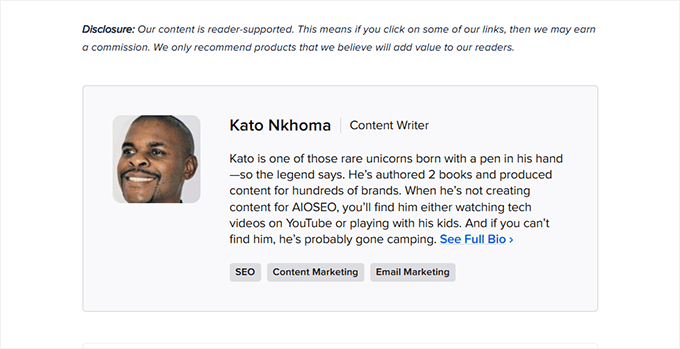

It lets me control how author names, dates, and schema appear so both users and AI can clearly see who’s behind the content.
If you want to go deeper, I recommend reading our full guide on what Google E-E-A-T means, written by Ben Rojas, the President of All in One SEO. It’s packed with tips for making your site more trustworthy, not just for Google but for all AI-driven platforms.
Step 10. Track AI Search Visibility and Traffic on Your WordPress Site
Normally, I recommend using Google Search Console to monitor how your site performs in search results.
But here’s the catch — Google doesn’t tell you if your content is being used in AI Overviews. There’s no clear label or report that shows whether you were featured in an AI summary or not.
That’s why I use MonsterInsights on my WordPress sites. It connects with Google Analytics and shows where your traffic is coming from, including AI tools like ChatGPT, Bing Copilot, and Perplexity.
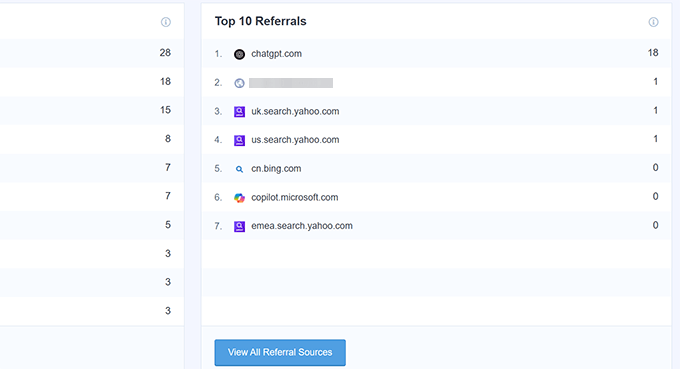

You can even track how visits from those platforms change over time by clicking on the ‘View All Referral Sources’ button.
If you want to go deeper, tools like GPTrends.io and Surfer SEO can help you track brand visibility or citations in ChatGPT and other AI responses. They’re powerful, but they come with a steep price tag.
You can also manually track your top keywords in Google Search Console and test them in AI tools to see if your site is mentioned in the results.
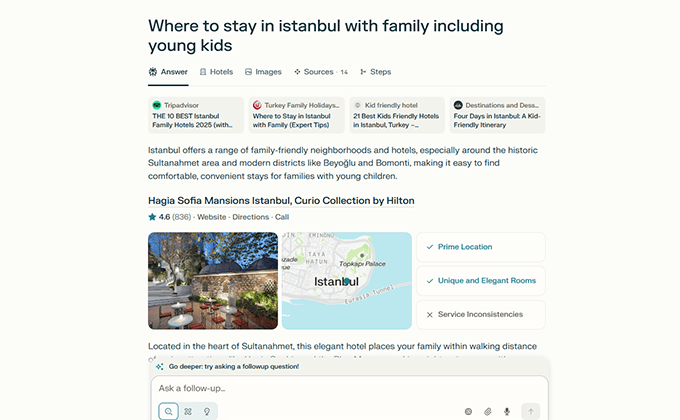

Until AI platforms offer more transparency, these are your best options for spotting opportunities and filling in the visibility gaps.
What Content Works Best for AI Search?
AI tools tend to favor content that’s clear, structured, and easy to summarize.
Here are the formats I’ve seen perform best in ChatGPT, Google’s AI Overviews, and other platforms.
Tutorials and How-To Guides: Step-by-step posts like “How to Start a Freelance Business” or “How to Make an Invoice in Excel” are easy for AI to break down into lists. Make sure to use numbered headings, short steps, and direct language.
Listicles and Comparisons: AI tools prefer clearly structured content. Using bullet points, subheadings, or comparison tables can make posts like “7 Free Logo Makers Compared” or “Mailchimp vs ConvertKit” easier to quote.
Opinion Posts With Clear Takeaways: Insight or experience-based articles work well when you include a summary or list of key points at the end. Make sure to include your name, author bio, and credentials to support E-E-A-T.
You do not need to change your niche. Just focus on formatting your content in a way that works for both readers and AI tools. Overall, a consistent layout makes it easier for AI to use your content in responses.
Bonus: Generative Engine Optimization Checklist for WordPress Users
Want to make your content easier for AI tools to understand, cite, and use in search answers?
Here is a quick checklist you can follow. I use this same list when optimizing content across my sites, and it works.
✅ Use simple, clear language that AI tools can easily understand.
✅ Begin with direct answers and follow with supporting details.
✅ Add schema markup using a plugin like All in One SEO.
✅ Use clear headings and subheadings to organize your content.
✅ Include a short summary or definition near the top of your post.
✅ Add FAQ sections that answer common user questions.
✅ Use a table of contents with jump links for easier navigation.
✅ Display the author name, publish date, and last updated date.
✅ Create an About page and author bios to support E-E-A-T.
✅ Use tools like MonsterInsights to track AI-related referral traffic.
Even if you only follow a few of these steps, you’ll be making your content more visible to AI search — and giving your site a better shot at getting cited.
Final Thoughts: Don’t Wait to Be Left Behind
Generative Engine Optimization isn’t a trend, it’s a shift. AI tools are already changing how people search, and they’re not slowing down anytime soon.
If your content isn’t ready for AI search, then you’re not just missing clicks. You’re also missing visibility and revenue, which is like leaving money on the table.
You don’t have to be a tech expert to optimize for AI. Most of it comes down to clear writing, good structure, established SEO best practices, and using the right tools.
That’s exactly why I recommend All in One SEO. It takes care of the technical stuff so you can focus on creating helpful content.
I’ve used AIOSEO on my personal projects as well as client sites. We also use it on WPBeginner and our partner sites, and I’ve seen it make a real difference in how AI tools pick up and display our content.
FAQs About Generative Engine Optimization
Generative Engine Optimization, also called AI Search Optimization, is still new and evolving. Here are answers to some of the most common questions I have received.
Is GEO the same as SEO?No, but they overlap. SEO helps your site rank in search engines. GEO helps your content get quoted by AI tools like ChatGPT, Gemini, and Google’s AI Overviews. The best approach is to focus on both.
How does structured data help with AI search?Structured data, also called schema markup, tells AI tools exactly what your content is about. It can highlight content types like FAQs, how-to guides, reviews, and more. Tools like All in One SEO make it easy to add schema to your posts.
Will Google’s AI Overviews replace regular search listings?Not completely, but they are already taking a large share of attention. A study by Ahrefs found that AI Overviews can reduce clicks to top-ranking pages by up to 34.5%. This is why it’s so important to structure your content for both search engines and AI tools.
What’s the best plugin to optimize WordPress for GEO?I recommend All in One SEO. It adds schema markup, connects to Google Search Console, includes a content analysis tool, and helps AI tools better understand and cite your content.
Can I appear in AI answers even if I’m not ranking high?Yes. I’ve seen low-ranking pages get featured in AI summaries because they provided a clear answer, strong structure, or relevant schema markup. Ranking still helps — but AI tools often prioritize clarity over position.
Learn More About GEO (AI + SEO) in WordPress
Want to go deeper into using AI tools, writing optimized content, and staying ahead in the AI search era? These guides from WPBeginner walk you through practical ways to apply AI inside WordPress, from writing to SEO to images.
If you’ve made it this far, you’re already ahead of most site owners. Generative Engine Optimization may sound technical, but at its core, it’s just about making your content clear, helpful, and easy to understand — both for people and for machines.
With the right structure and tools, you can stay visible in the age of AI and continue growing your WordPress site with confidence.
If you liked this article, then please subscribe to our YouTube Channel for WordPress video tutorials. You can also find us on Twitter and Facebook.

